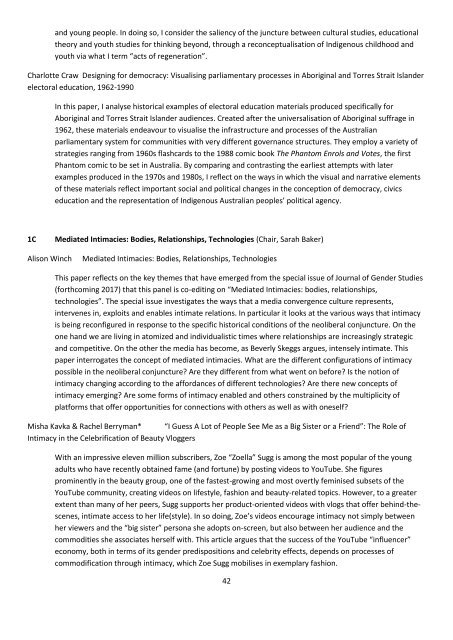Crossroads in Cultural Studies Conference 14-17th December 2016 Program Index
Crossroads-2016-final-draft-program-30-Nov
Crossroads-2016-final-draft-program-30-Nov
You also want an ePaper? Increase the reach of your titles
YUMPU automatically turns print PDFs into web optimized ePapers that Google loves.
and young people. In do<strong>in</strong>g so, I consider the saliency of the juncture between cultural studies, educational<br />
theory and youth studies for th<strong>in</strong>k<strong>in</strong>g beyond, through a reconceptualisation of Indigenous childhood and<br />
youth via what I term “acts of regeneration”.<br />
Charlotte Craw Design<strong>in</strong>g for democracy: Visualis<strong>in</strong>g parliamentary processes <strong>in</strong> Aborig<strong>in</strong>al and Torres Strait Islander<br />
electoral education, 1962-1990<br />
In this paper, I analyse historical examples of electoral education materials produced specifically for<br />
Aborig<strong>in</strong>al and Torres Strait Islander audiences. Created after the universalisation of Aborig<strong>in</strong>al suffrage <strong>in</strong><br />
1962, these materials endeavour to visualise the <strong>in</strong>frastructure and processes of the Australian<br />
parliamentary system for communities with very different governance structures. They employ a variety of<br />
strategies rang<strong>in</strong>g from 1960s flashcards to the 1988 comic book The Phantom Enrols and Votes, the first<br />
Phantom comic to be set <strong>in</strong> Australia. By compar<strong>in</strong>g and contrast<strong>in</strong>g the earliest attempts with later<br />
examples produced <strong>in</strong> the 1970s and 1980s, I reflect on the ways <strong>in</strong> which the visual and narrative elements<br />
of these materials reflect important social and political changes <strong>in</strong> the conception of democracy, civics<br />
education and the representation of Indigenous Australian peoples’ political agency.<br />
1C<br />
Mediated Intimacies: Bodies, Relationships, Technologies (Chair, Sarah Baker)<br />
Alison W<strong>in</strong>ch<br />
Mediated Intimacies: Bodies, Relationships, Technologies<br />
This paper reflects on the key themes that have emerged from the special issue of Journal of Gender <strong>Studies</strong><br />
(forthcom<strong>in</strong>g 2017) that this panel is co-edit<strong>in</strong>g on “Mediated Intimacies: bodies, relationships,<br />
technologies”. The special issue <strong>in</strong>vestigates the ways that a media convergence culture represents,<br />
<strong>in</strong>tervenes <strong>in</strong>, exploits and enables <strong>in</strong>timate relations. In particular it looks at the various ways that <strong>in</strong>timacy<br />
is be<strong>in</strong>g reconfigured <strong>in</strong> response to the specific historical conditions of the neoliberal conjuncture. On the<br />
one hand we are liv<strong>in</strong>g <strong>in</strong> atomized and <strong>in</strong>dividualistic times where relationships are <strong>in</strong>creas<strong>in</strong>gly strategic<br />
and competitive. On the other the media has become, as Beverly Skeggs argues, <strong>in</strong>tensely <strong>in</strong>timate. This<br />
paper <strong>in</strong>terrogates the concept of mediated <strong>in</strong>timacies. What are the different configurations of <strong>in</strong>timacy<br />
possible <strong>in</strong> the neoliberal conjuncture? Are they different from what went on before? Is the notion of<br />
<strong>in</strong>timacy chang<strong>in</strong>g accord<strong>in</strong>g to the affordances of different technologies? Are there new concepts of<br />
<strong>in</strong>timacy emerg<strong>in</strong>g? Are some forms of <strong>in</strong>timacy enabled and others constra<strong>in</strong>ed by the multiplicity of<br />
platforms that offer opportunities for connections with others as well as with oneself?<br />
Misha Kavka & Rachel Berryman* “I Guess A Lot of People See Me as a Big Sister or a Friend”: The Role of<br />
Intimacy <strong>in</strong> the Celebrification of Beauty Vloggers<br />
With an impressive eleven million subscribers, Zoe “Zoella” Sugg is among the most popular of the young<br />
adults who have recently obta<strong>in</strong>ed fame (and fortune) by post<strong>in</strong>g videos to YouTube. She figures<br />
prom<strong>in</strong>ently <strong>in</strong> the beauty group, one of the fastest-grow<strong>in</strong>g and most overtly fem<strong>in</strong>ised subsets of the<br />
YouTube community, creat<strong>in</strong>g videos on lifestyle, fashion and beauty-related topics. However, to a greater<br />
extent than many of her peers, Sugg supports her product-oriented videos with vlogs that offer beh<strong>in</strong>d-thescenes,<br />
<strong>in</strong>timate access to her life(style). In so do<strong>in</strong>g, Zoe’s videos encourage <strong>in</strong>timacy not simply between<br />
her viewers and the “big sister” persona she adopts on-screen, but also between her audience and the<br />
commodities she associates herself with. This article argues that the success of the YouTube “<strong>in</strong>fluencer”<br />
economy, both <strong>in</strong> terms of its gender predispositions and celebrity effects, depends on processes of<br />
commodification through <strong>in</strong>timacy, which Zoe Sugg mobilises <strong>in</strong> exemplary fashion.<br />
42


